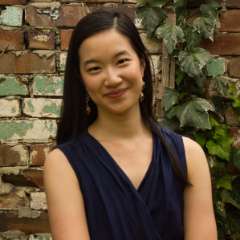Opera Australia’s annual Handa Opera on Sydney Harbour is a spectacular high point of the year. Performed on a giant floating stage at Mrs Macquarie’s Point, the backdrop of Sydney’s world-famous Harbour skyline practically guarantees that any production will have a breathtaking grandeur. It’s the sort of vista that opera – with its soaring passions and life-or-death magnificence – is made for.
And this production of La traviata, set in the glamorous 1950s, is really spectacular. The fireworks (a feature of every Handa Opera) explode in front of the Harbour Bridge and Sydney Opera House as a festive climax to the gusty Brindisi. The stage is an enormous gilt-framed mirror floor measuring over 30 metres each way. The Act 1 showpiece, “Sempre libera”, has Violetta soaring vocally and physically across the stage in a 3.5 tonne chandelier. Alfredo’s country house is signified by a glamorous silver sofa that is double the length of the average Sydney apartment. And Act 2 has the cast shuttling across the harbour in a real Sydney Harbour water taxi (which they naturally turn into a party boat).
This production was the first Handa Opera on Sydney Harbour, staged in 2012 by Francesca Zambello, director of the Washington National Opera and the Glimmerglass Festival. It was so well-received she directed a subsequent Handa Opera, 2019’s West Side Story, which went on to win a Helpmann Award for best direction of a musical. I am a big fan of Zambello’s theatrical instinct, and it is wonderful to enjoy her work again in this restaging, delayed a year due to the pandemic but fortunately kept on the OA programme. There are some added touches from the revival director, Constantine Costi, and some new musical-inspired choreography by Shannon Burns. Brian Thomson’s striking set also now has an added 30 metre neon strip light to outline a Paris skyline (although this was a bit incongruent with the actual Sydney harbour skyline behind it). Tess Schofield makes fantastic use of bright block colours for costuming – true to the period and radiantly effective on the enormous stage.
While the full-blooded party scenes in this production are dazzling fun and brilliantly staged, Traviata’s pivotal moments occur around intimate scenes – the duets and solos that reveal the inner struggles and passions of Violetta, Alfredo and Giorgio Germont. Casting Traviata well is essential, and the casting in this production is very good.
OA favourite Stacey Alleaume gives a heartrendingly triumphant performance as Violetta. She has a beautiful, sweet-toned soprano with shimmering, deceptively effortless top notes and stunning vocal precision. More importantly, she is a compellingly sincere artist who fully inhabits Violetta’s humanity, and brings the audience along the journey. We feel Violetta’s love, struggle, heartbreak, humiliation and misplaced hope through Alleaume’s inspired storytelling, so that when Germont weeps over Violetta at the end of Act 2, so do we. It’s this rare kind of artistic sincerity, where incredible technical ability is put at the service of heartfelt emotion, that makes really memorable performances, and the production is worth attending for Alleaume alone.
Rame Lahaj is a dashing presence as Alfredo – tall, dark, and brooding against Alleaume’s open, sparkling Violetta. He sings with passion and has a warm, rich tenor with a charming smoothness and sense of line. His humiliation of Violetta – where he violently throws playing cards at her collapsed form with savage calculation – was the most believable facet of his Alfredo, and made me rethink the character as more immature and toxic than I’d previously imagined. I would have loved to have seen the other parts of his Alfredo realised as fully.
Michael Honeyman is an extremely dignified, solid Germont, singing with a warm, reproachful baritone. His Act 2 duets with Violetta are extremely moving and one of the emotional high points of the production. The three leads are backed up by confident performances from Celeste Haworth as the jaded courtesan Flora, up-and-coming singer Danita Weatherstone as a streetsmart Annina, John Longmuir as Gastone, Alexander Sefton as a smoothly evil Baron, Andrew Moran as the Marquis D’Obigny, and Gennadi Dubinsky as the somewhat helpless Doctor Grenvil.
A special shoutout to the dancers and chorus, who invigorated their singing and dancing with dynamic vitality. It’s no mean feat to create that kind of energy in such a huge space. Brian Castles-Onion conducted the orchestra, out of sight but not out of mind under-stage, through a lively rendition of the score, and the sound was well balanced through Des O’Neill’s sound design.
Such a beautiful production was, fittingly, dedicated to the memory of the much-loved Australian soprano Taryn Fiebig, whose passed away earlier in the week.




